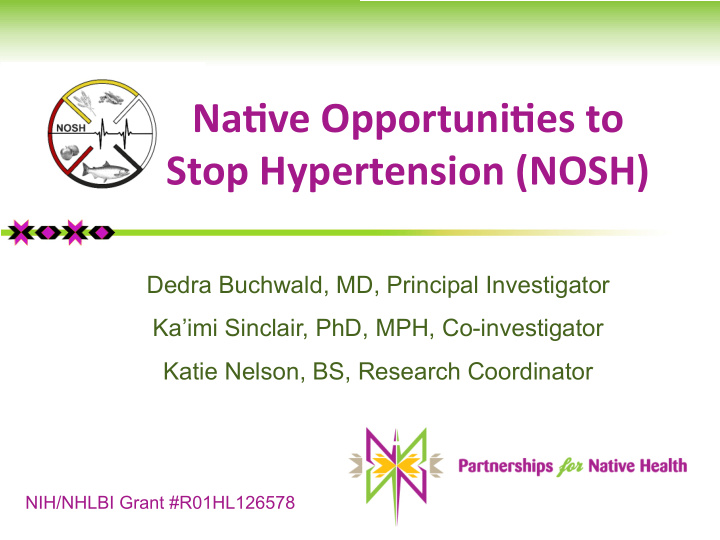



Na#ve Opportuni#es to Stop Hypertension (NOSH) Dedra Buchwald, MD, Principal Investigator Ka’imi Sinclair, PhD, MPH, Co-investigator Katie Nelson, BS, Research Coordinator NIH/NHLBI Grant #R01HL126578
Background § Cardiovascular disease (CVD) most common cause of death in the U.S. Ø Hypertension a primary risk factor for CVD Ø Almost 50% of U.S. adults have high blood pressure Ø Only half have their high blood pressure under control § American Indians experience disproportionate burden of hypertension and cardiovascular disease compared to other races
Background § Medications alone sub-optimal § Lack of hypertension interventions for urban American Indians § Heart-healthy diet can improve control of hypertension with or without medication
The DASH Diet § Dietary Approaches to Stop Hypertension (DASH) § Evidence-based eating plan § Promotes low sodium, low fat foods for prevention of cardiovascular disease and blood pressure control
NOSH Native Opportunities to Stop Hypertension § Evaluate personalized DASH diet intervention in American Indian/Alaska Native clinic patients with uncontrolled hypertension § Two clinics : – Spokane, Washington – Purcell, Oklahoma – 185 participants in each site
Eligibility Eligibility Criteria: ü 18 years of age or older, ü Diagnosed hypertension for at least 1 year, ü Stable routine of antihypertensive medications for at least 2 months OR not currently medicated, ü No anticipated changes in medication for the duration of the study, ü Systolic BP ≥ 140 mmHg at the past 2 clinic visits and at the in-person screening visit.
Study Design § Participants randomized to: 1. Wait list condition – booklet with information about low-salt diet, or 2. NOSH Intervention – 60 minute nutrition counseling session at baseline + 8 weekly NOSH educational sessions § All participants receive home blood pressure monitor and order $30 of groceries each week for 8 weeks § Study assessments conducted at baseline, 8 and 12 weeks. Participants receive a $50 gift card for each visit
Data Collected
Intervention § Dietitian delivered NOSH curriculum § 8 individual 20-minute sessions completed in person or over the phone 1. Seasoning without sodium 2. Fruits instead of processed sweets 3. Vegetables 4. Nuts, seeds, and beans 5. Whole grains 6. Healthy fats 7. Low-fat dairy and dairy alternatives 8. Lean meat, poultry, fish
Cultural Adaptation • Delivered by Native dietitians & staff • Includes Native foods Candy Jackson, RD Spokane Native Clinic
Data Collection § Blood pressure § Measurements from home § Measurements at clinic § Eating habits § ASA24 Hour Dietary Recalls § 24 hour urine samples to measure sodium and potassium § Weekly grocery orders § Fruit & Vegetable and Fat Screener (NCI surveys) § Body Mass Index § Cholesterol § Survey (lifestyle behaviors and medical history)
Study Status Recruitment: § September, 2017 in Oklahoma § November, 2017 in Washington. § Total of 35 participants recruited and enrolled
Successes and Challenges Challenges to recruitment § Hypertension under control among many clinic patients § New recommendations for blood pressure control may increase aggressive treatment of hypertension Success § Positive feedback about NOSH intervention
Conclusion § Diets that reduce salt consumption have great potential to control blood pressure and prevent cardiovascular disease § First study with urban American Indians § NOSH intervention includes novel features: § Nutritional counseling from Native dietitians and staff § Inclusion of traditional Native foods in eating plan
Thank you! Questions?
Recommend
More recommend